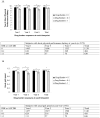Drug burden index score and functional decline in older people
- PMID: 19958893
- PMCID: PMC3263511
- DOI: 10.1016/j.amjmed.2009.02.021
Drug burden index score and functional decline in older people
Abstract
Background: The Drug Burden Index (DBI), a measure of exposure to anticholinergic and sedative medications, has been independently associated with physical and cognitive function in a cross-sectional analysis of community-dwelling older persons participating in the Health, Aging and Body Composition study. Here we evaluate the association between DBI and functional outcomes in Health, Aging and Body Composition study participants over 5 years.
Methods: DBI was calculated at years 1 (baseline), 3, and 5, and a measure of the area under the curve for DBI (AUCDB) over the whole study period was devised and calculated. Physical performance was measured using the short physical performance battery, usual gait speed, and grip strength. The association of DBI at each time point and AUCDB with year 6 function was analyzed in data from participants with longitudinal functional measures, controlling for sociodemographics, comorbidities, and baseline function.
Results: Higher DBI at years 1, 3, and 5 was consistently associated with poorer function at year 6. On multivariate analysis, a 1-unit increase in AUCDB predicted decreases in short physical performance battery score of .08 (P=.01), gait speed of .01 m/s (P=.004), and grip strength of .27 kg (P=.004) at year 6.
Conclusion: Increasing exposure to medication with anticholinergic and sedative effects, measured with DBI, is associated with lower objective physical function over 5 years in community-dwelling older people.
Figures


References
-
- Steel K, Gertman PM, Crescenzi C, Anderson J. Iatrogenic illness on a general medical service at a university hospital. N Engl J Med. 1981;304(11):638–42. - PubMed
-
- Montamat SC, Cusack B. Overcoming problems with polypharmacy and drug misuse in the elderly. Clin Geriatr Med. 1992;8(1):143–58. - PubMed
-
- Gray SL, Penninx BW, Blough DK, Artz MB, Guralnik JM, Wallace RB, et al. Benzodiazepine use and physical performance in community-dwelling older women. J Am Geriatr Soc. 2003;51(11):1563–70. - PubMed
-
- Mulsant BH, Pollock BG, Kirshner M, Shen C, Dodge H, Ganguli M. Serum anticholinergic activity in a community-based sample of older adults: relationship with cognitive performance. Arch Gen Psychiatry. 2003;60(2):198–203. - PubMed
Publication types
MeSH terms
Substances
Grants and funding
LinkOut - more resources
Full Text Sources
Medical

